During the development of stomach cancer, cancer cells form within the stomach lining. Tumors can be formed from these cells. The disease, also known as gastric cancer, grows slowly over time. The late 60s and early 80s are the most common age range for stomach cancer. The glandular tissue lining the stomach is the most common site for it. Cancerous cells may be shed into the lymphatic system or the bloodstream from the tumor. The tumor may grow along the stomach wall or it may grow directly through the wall. When cancer spreads beyond the stomach, it can affect other organs as well.
Causes of Stomach Cancer:
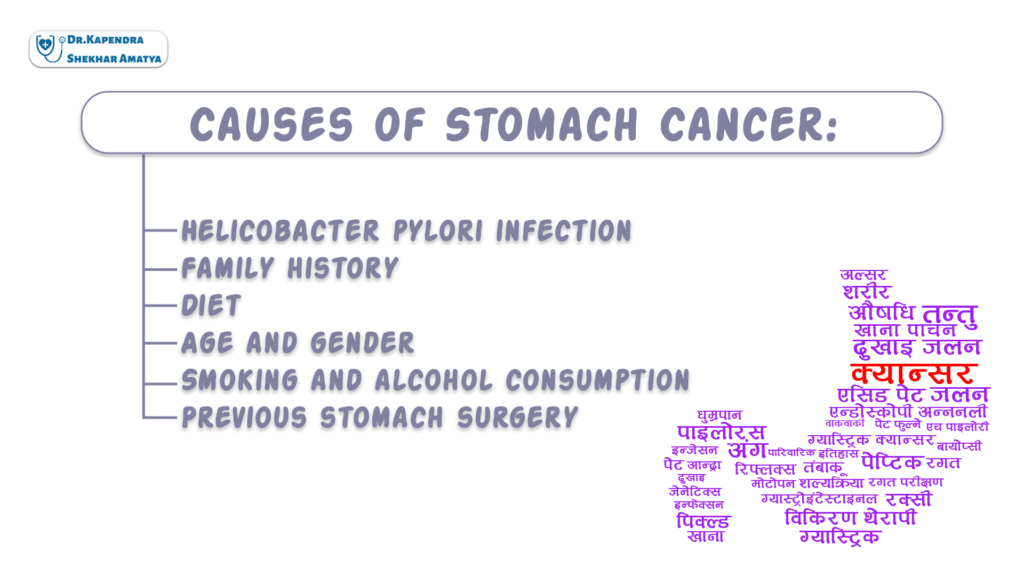
The exact cause of cancerous cells growing in the stomach is unknown to scientists. Nevertheless, some factors can increase your risk. The most common cause of ulcers is infection with the bacteria H pylori. Your chances of getting cancer are also increased by intestinal inflammation called gastritis, long-term anemia called pernicious anemia, and growths in the stomach called polyps.
Types of Stomach Cancer:
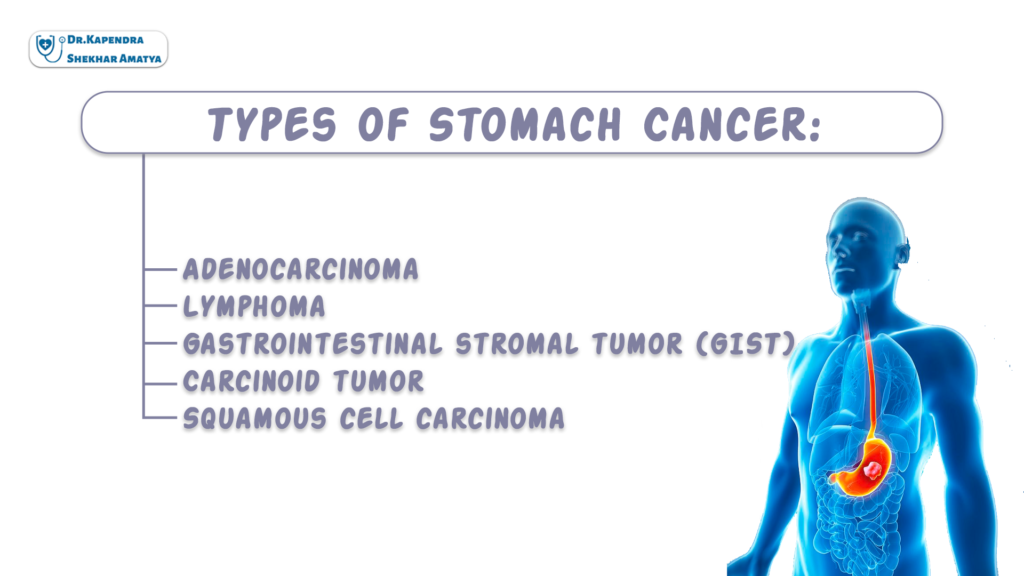
The different layers of the stomach are gradually penetrated by stomach cancer. The staging process determines how serious the cancer is and how best to treat it based on how far it has spread within the stomach wall.
Stomach cancer can be classified into several types:
• Adenocarcinomas
• Gastrointestinal stromal tumors
• Neuroendocrine tumors
• Lymphomas
Adenocarcinomas:
In most cases, stomach cancer is an adenocarcinoma. In the innermost lining of the stomach, these cancers are caused by gland cells. In most cases when stomach cancer is diagnosed, it is an adenocarcinoma. Adenocarcinomas of the stomach can be classified into two main types:
• The intestinal type
• The diffuse type
Gastrointestinal stromal tumors:
Interstitial cells of Cajal play a crucial role in the formation of these uncommon tumors in the stomach’s wall. Some GISTs are more likely to spread outside the body or to grow in other areas. The majority of GISTs start in the stomach, but they can begin anywhere in the digestive tract.
Neuroendocrine tumors:
Cells within the stomach or other parts of the digestive tract can cause neuroendocrine tumors, which act in some ways like nerves and others like hormone-producing cells. Some NETs can grow quickly and spread to other organs, while others grow slowly and don’t spread.
Lymphomas:
Lymphocytes, which are cells of the immune system, are the origin of these cancers. There is a possibility that lymphomas can begin in the stomach wall because they usually begin in other parts of the body. Treatments and outlooks for lymphomas differ depending on their type.
Signs & Symptoms of Stomach Cancer:

It is often difficult to recognize stomach cancer in the early stages because many of its symptoms are similar to those of less serious conditions. The following symptoms are present in the early stages:
• Having an ongoing digestive issue
• Burping and trapped wind
• Burning sensations
• Feeling full after eating very quickly
• After eating, feeling bloated
• Sickness
• An uncomfortable feeling in your stomach or breastbone
• Swallowing difficulties
• Vomiting.
The following are symptoms of more advanced stomach cancer:
• Stools that are black or have blood in them
• A lack of appetite
• Reduction in weight
• Feeling tired
• Stomach lumpiness and swelling
• Anemia
• The whites of the eyes and skin become yellow.
Risk Factors of Stomach Cancer:
You might develop cancerous cells in your stomach if you are exposed to certain factors. The following diseases and conditions may increase your risk of developing these diseases and conditions:
• Infections caused by H. pylori
• A tumor in another part of the digestive system
• Having polyps in your stomach
• Genetic syndromes inherited from parents.
You can develop stomach cancer regardless of your medical history, but certain lifestyle factors can also increase your risk. The following factors may increase your risk of stomach cancer:
• Consume a lot of salty or processed foods
• Regularly eat meat
• Eat fruit rarely or never
• Consume a lot of alcohol
• Don’t exercise enough
• Smoking
• Cook or store food improperly
Preventive Measures for Stomach Cancer:

There is no way to prevent stomach cancer on its own. You can, however, reduce your chances of developing any cancer by:
• Weight maintenance
• Maintaining a balanced diet
• Drinking in moderation
• Don’t smoke
• Regular exercise. There are some cases in which doctors prescribe medications that can reduce the risk of stomach cancer. Patients who have a precancerous condition or who suffer from other diseases that are also treated with this medication are usually prescribed this treatment.
Diagnosis of Stomach Cancer:
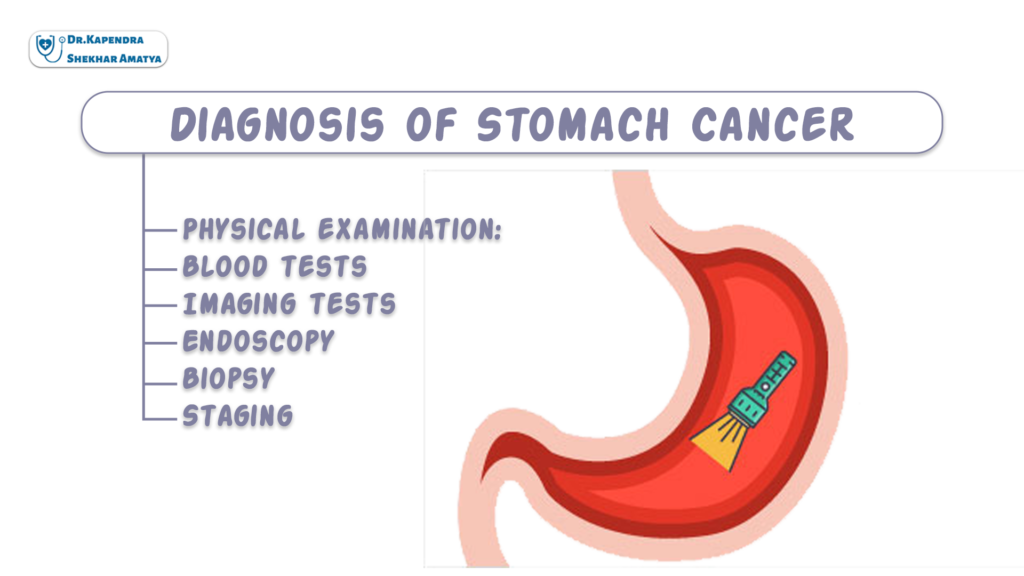
A gastroenterology appointment includes a thorough physical examination, blood and stool samples, and detailed questions about your health. A clinical decision will be guided by these details, which provide many important details to your doctor. Imaging tests may be requested by your doctor, including:
• PET scans
• Upper gastrointestinal endoscopy
• Endoscopic ultrasound.
PET scans:
Nuclear medicine procedure PET measures the metabolic activity of body tissues by measuring the emission of positrons. Nuclear medicine and biochemistry are combined in PET. It is possible to visualize biochemical changes that are occurring within the body, such as heart muscle metabolism, using PET imaging in patients suffering from brain or heart disease.
Upper gastrointestinal endoscopy:
Your upper GI tract is examined by an upper GI endoscopy, also known as an EGD. You have the first part of your small intestine and your food pipe in your upper GI tract. Endoscopes are long, flexible tubes used for this procedure. One end of the tube has a small light and video camera. Tubes are inserted into mouths and throats. Once it reaches the duodenum, it is slowly pushed through the esophagus and stomach. Monitors display video images from the tube.
Endoscopic ultrasound:
With this test, an endoscope is used with an ultrasound probe, which generates sound waves to create images of your digestive tract. Especially useful for seeing layers beyond the inner lining, such as the middle and outer layers. Using this test, your doctor can determine whether the tumor has spread and how deep it is.
Stages of Stomach Cancer:
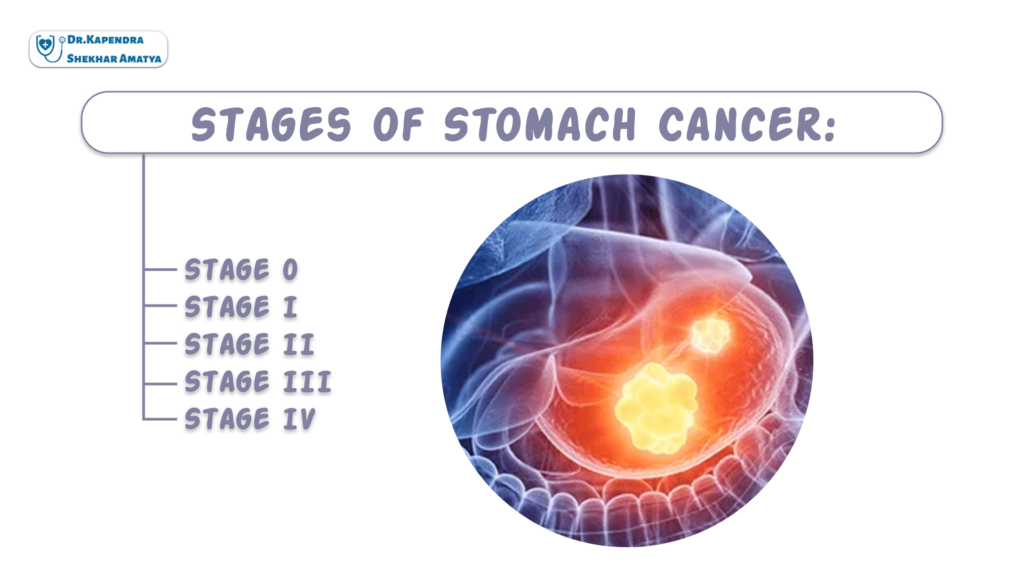
Stages of stomach cancer indicate the extent of the disease. A stage of 0 to 4 is determined based on the findings in each category. An earlier cancer stage is represented by a lower number.
• Stage 0: An abnormal or cancerous cell has been found on the stomach lining’s surface, but it has not spread to the lymph nodes or elsewhere in the body.
• Stage 1: Several layers of the stomach have been affected by the tumor. Cancer may have spread to one or two lymph nodes around the stomach, but it has not spread elsewhere in the body.
• Stage 2: A deeper layer of the stomach has been affected by the tumor, and cancer has often spread to the lymph nodes. Currently, it hasn’t spread elsewhere in the body.
• Stage 3: Possibly, the tumor has spread to nearby organs as well as deeper into the stomach. Despite spreading to lymph nodes, cancer has not spread to distant organs.
• Stage 4: In some cases, cancer may have spread to deeper layers of the stomach or nearby lymph nodes, but this isn’t necessary.
When cancer has spread to distant organs such as the lungs, brain, or liver, it has reached an advanced stage.
Treatment for Stomach Cancer:

An individual’s stomach cancer treatment depends on several factors, such as their overall health and preferences, as well as the severity of their cancer. The following treatments are available:
• Surgery
• Radiation therapy
• Chemotherapy
• Targeted therapy
• Immunotherapy
Surgery:
There is a possibility that doctors will need to remove not only the stomach cancer but also a margin of healthy tissue from the area. In addition to endoscopic mucosal resections, subtotal gastrectomy, and total gastrectomy may be performed.
Radiation therapy:
Radioactive rays are used to target and kill cancerous cells by specialists. Treatment for stomach cancer does not usually involve this type of therapy. Cancers that are advanced or cause severe symptoms or tumors that need to be shrunk before surgery may need this treatment.
Chemotherapy:
Cancer cells are stopped from dividing and multiplying by cytotoxic drugs used in this specialist treatment. Whenever stomach cancer spreads to distant areas of the body, chemotherapy is used as the primary treatment. To shrink tumors or kill remaining cancer cells, chemotherapy can be administered before or after surgery.
Targeted therapy:
Specific proteins produced by cancer cells are recognized and attacked by these therapies. A team of cancer care providers administers two targeted medications through intravenous (IV) infusions to patients with stomach cancer. Ramucirumab and Trastuzumab are the two drugs.
Immunotherapy:
Medicines are used in this treatment to stimulate the body’s immune system to attack cancer cells. A candidate for immunotherapy is someone with advanced stomach cancer who has already undergone more than one treatment.
When to See an Oncologist in Nepal?
When you observe any of the symptoms of stomach cancer, it is best suggested to consult with the cancer specialist as soon as possible. You can make an appointment with either a medical or surgical oncologist. Your cancer-treating doctor will then check you thoroughly and will let you know about the condition. As per the top surgical oncologist in Nepal, Dr. Kapendra Shekhar Amatya, you must be able to cope with your doctor and share every possible experiences with them to make the treatment procedure much more effective.
Causes of Colorectal Cancer and Preventive Measures

MS (NMC Regd.2902)
Head of the Department, Sr.Consultant Surgical Oncologist at Nepal Cancer Hospital and Research Center
Director: Breast Cancer Program
Interest: Breast Cancer Surgery, Gastro Intestinal Cancer Surgery (Stomach and Colo-Rectal Cancer)

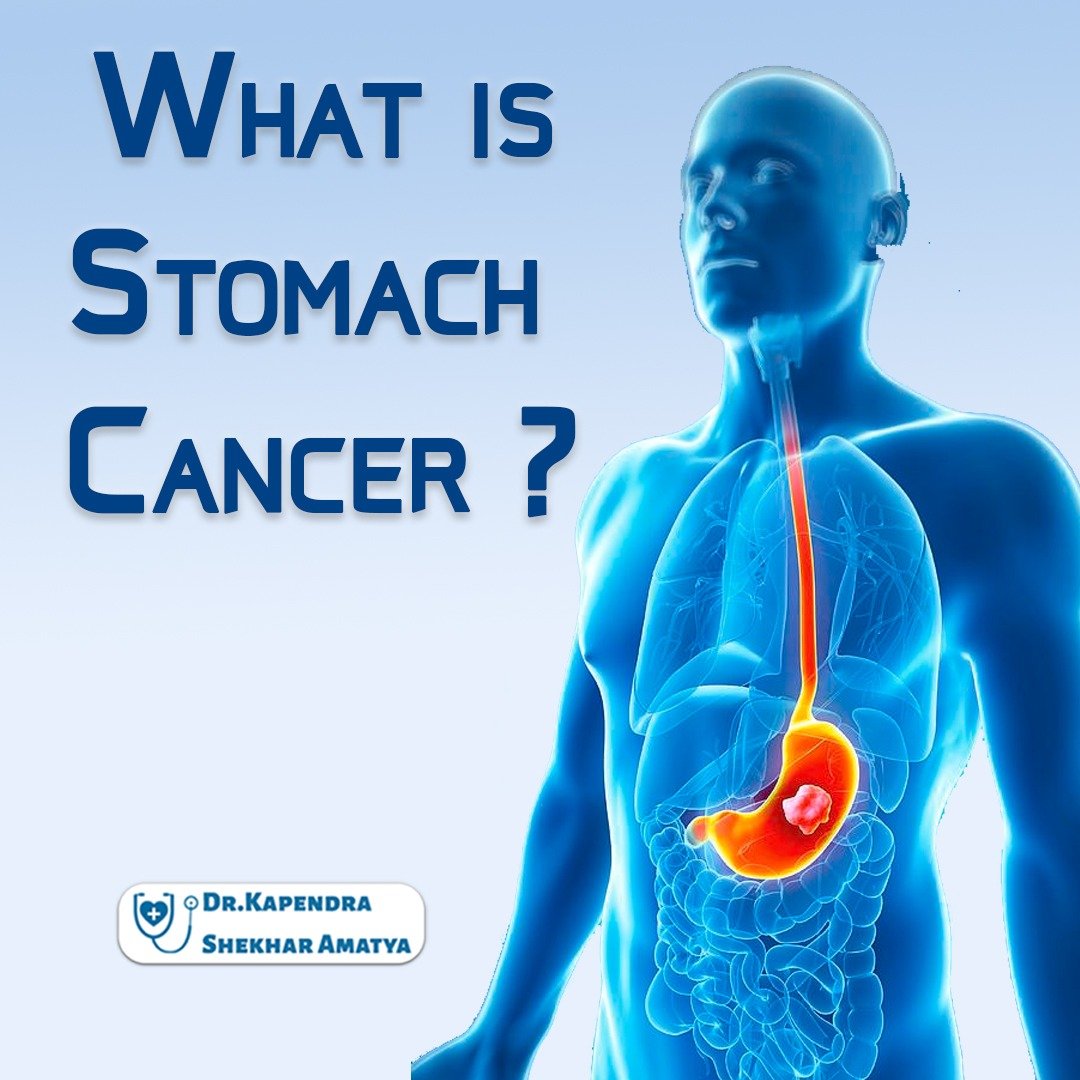

2 thoughts on “Stomach Cancer”